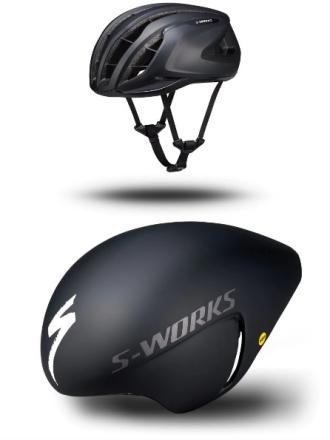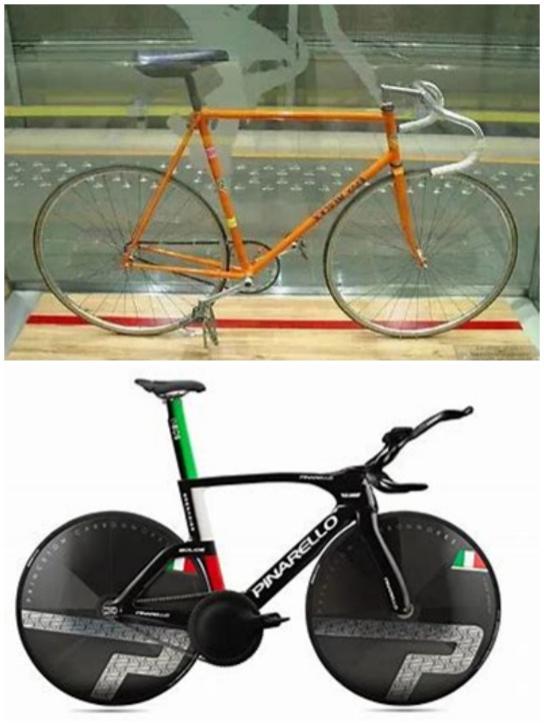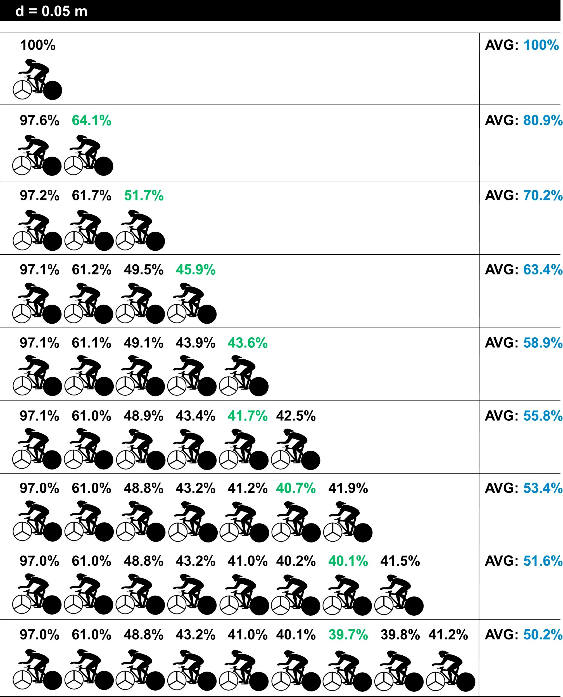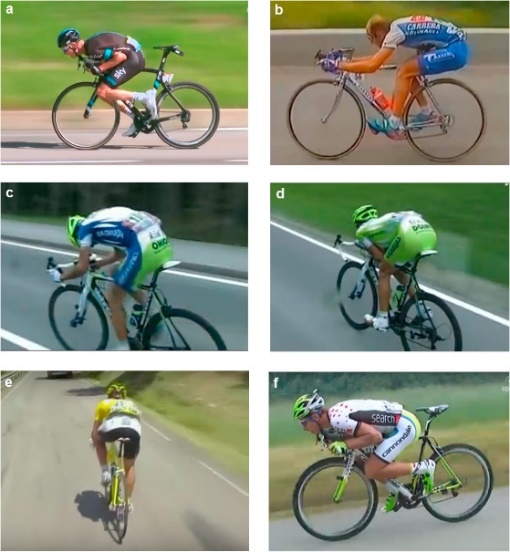1. Introduction
When a bicycle moves through the air, the air exerts a force on the rider called air resistance, also known as wind resistance/Drag. The study of the characteristics of this force in the case of relative motion is known as Aerodynamics. Aerodynamic drag is actually proportional to the Effective Frontal Area (EFA), Veloity and Drag Coefficent. When the Effective Frontal Area is doubled, the drag doubles, and when the drag coefficent is doubled, the drag doubles. But when the speed is doubled, the drag is tripled to four times the original. Therefore, it has a very large impact on the cyclist's energy loss from pedaling. This is because many scholars have studied the effect of air resistance through data simulation or wind tunnel testing, and applied the results to bicycle racing, including riding position, race tactics, and bicycle design [1]. Moreover, with the continuous improvement of bicycle materials, the aerodynamic optimization of bicycles is becoming more and more important in bicycle racing. Therefore, this paper analyzes the application of aerodynamics in cycling by means of literature review.
2. Aerodynamic in cycling
2.1. Factors affecting cycling speed
2.1.1. Wind drag. Wind drag is the main thing that prevents riders from accelerating. Crouch et al. claim that the wind drag of the bicycle accounts for 60 percent of all resistance in cycling, and the wind drag of the rider accounts for another 20 percent [2]. So, as the speed increases, it will be more and more important to make the riding more aerodynamic, which enables the riders to ride faster when putting out the same power.
2.2. Measurement of cycling speed: one-hour record
A one-hour record is the most Is the most representative and direct reflection of the progress of cycling. Because it is always held on the indoor cycling track, there is minimal influence from the weather and the road condition. And because it is held on the cycling track and doesn’t have the demand of a sudden break or velocity change, the one-hour record bikes are mostly designed without a break or speed control system, which enables the bike to become more aerodynamic. And because of the structure, the one-hour record bikes are simplified a lot compared to normal road bikes, which reduces the proportion of drag generated by other parts and makes wind resistance play a decisive role. As a result, it can nearly become a standard measure of the aerodynamic level of the bicycle. Although it is only nine years since the International Cycling Union (UCI) changed the regulation of the one-hour record in 2014, this record has improved quite a bit. From Jens Voigt’s 51.115 km in 2014 to Filippo Ganna’s 56.792 km in 2022, it can be easily seen that it really improves a lot and is closely related to the development of bicycle aerodynamics [3].
3. The aerodynamic of the rider
As the speed of the ride increases, the effect of the wind gradually increases, resulting in significant wind resistance. This not only hinders acceleration, but also uses more energy. It is important to note that wind resistance increases rapidly as the rider accelerates. Therefore, it is very important to take measures to reduce wind resistance [4].
In order to measure the aerodynamic performance of the rider, there are a lot of ways. The main choices are usually the wind tunnel and CFD. For the wind tunnel, it is always putted a human model in the tunnel, and in order to show the flow of the wind more directly, there is often some smoke mixed with the wind so that people can see the change of the wind more clearly.
3.1. Downhill position
Optimizing the body position starts with the fastest time on the ride, which should usually be when going downhill. In most instances, there is no need to pedal when going downhill, and the conversion of gravity and kinetic energy is used to increase the speed. Therefore, all that needs to be considered for position optimization when descending is how to optimize the exit position. Although the UCI has changed the regulation that the rider must sit on the saddle when going downhill in consideration of the riders’ safety in 2021, the variety of downhill positions in previous years is still an interesting topic worth talking about. According to Figure 1, it is easy to see that everyone is trying hard to make his body have a smaller front area in order to be less influenced by the wind [5].
| Figure 1. The downhill position: (a) on the front part of the top tube; (b) behind the saddle; (c). on the saddle in the ‘back horizontal’ position; (d) forearms tucked in; (e) in the ‘back up’ position; (f) on the rear part of the top tube. |
3.2. Sprint position
Another occasion on which the riders go very fast is when sprinting, but it’s not like going downhill. The riders need to paddle very hard and try to generate maximum power when sprinting. So, the position can’t be as aggressive as going downhill, and the details are becoming more important. Maybe the sprinter can save a few watts or even tens of watts of power at the same speed just by lowering the head. What’s more, just like going downhill, lowering the body is also very important in sprinting. When the body gets lower, the windward area of the rider will definitely become slower, and that will be a big aerodynamic benefit for the rider [6]. In Figure 2, there is a CFD analysis of two sprint positions. The upper two pictures show the wind speed, and the lower two show the pressure. In the position on the right, the rider’s back is lower, and the space between the body and the bike is much smaller. From the upper two pictures, it clearly shows that by lowering the body, the air flow of the position on the right is much smoother than the left one, which enables the rider to be impacted less by the turbulence around him. What’s more, in the lower two pictures, we can easily see that because the body is lower and closer to the bike on the left, the low-pressure area behind the rider is much smaller, and the high-pressure area under the rider’s body is smaller as well, which can reduce the drag force behind the rider and the resistance force in front of the rider.

Figure 2. A CFD analysis of two sprint position: (a)wind speed-with higher back; (b)wind speed-with lower back; (c)the pressure-with higher back; (d)the pressure-with lower back.
3.3. Personal equipment
In addition to riding position, another important factor is personal equipment. First of all, when riding, riders give preference to leather jackets because they are light, fit the body well, minimize the effect of wind resistance, and do not become a burden to the rider because of their weight. Another important thing for riders is the helmet. Helmets are often thought of as being used to protect the rider from injury. But the truth is that the design and function of a helmet are much more complex than one might think. The design of a helmet takes into account a number of factors, such as the total volume (to avoid placing a burden on the rider's neck), and ventilation (to ensure that the rider doesn't get sweltering hot during long rides) [7].
The aerodynamic properties of the helmet are also important. As shown in Figure 3, the helmet above is the one used on long rides or mountain rides, it has more riser vents and weighs less. The helmet below is heavier in total and has only a few riser vents, so it is not very comfortable to wear. However, due to its near-perfect streamlined design, it allows airflow to pass smoothly through the helmet, resulting in less drag. This is why this helmet is mostly used for timed trail races. Time trial races are usually shorter than other tracks, and the aerodynamic performance is tested most rigorously, so riders sacrifice some weight and comfort by choosing the gear with the best aerodynamic performance [8].

Figure 3. The helmet.
4. The aerodynamic of the bicycle
The most important part of optimizing aerodynamics is optimizing the bicycle. In fact, similar to the basic theory of aerodynamic optimization of the riders, the main part of the aerodynamic optimization of the bicycle is also based on reducing the windward area and the overall drag. Which mainly include the optimization of the frameset and the wheelset of the bicycle.
4.1. Bicycle frames
The frame is the most important part of the bike. It is like a core that connects all parts of the bike. The bike in Figure 4 is a newer bike with a thicker tube pattern that allows airflow through the bike more smoothly, resulting in less drag. Disc wheels and a closed crankset are also used to reduce wind pressure. Additionally, the seat tubes utilize Humpback Whale Bionic Technology, which is made up of tiny bumps that effectively direct airflow at high speeds, helping to reduce a great deal of drag. While its design may be a bit unconventional, this new bike is a good example of the general trend in cycling development. What's more, the tube shapes are also for aerodynamics, and most of them are designed in a teardrop shape that directs the airflow perfectly and produces less drag [9].

Figure 4. Newer bike.
4.2. Other content of the bicycle
When sorting the components of the bike by size, right after the frame, the second largest one is the wheel, and for the wheel, just like the frame, the one with a thicker tube will have better aerodynamic performance. The research shows that the one with a deeper rim will have better aerodynamic performance. The two sides of the wheel are completely closed, so there won’t be any turbulence generated in the wheel set, and the air flow will pass it smoothly without generating any drag force. But because it is closed, its ability to resist the crosswind is very weak, and its weight is nearly the weight of two normal wheels, so it is only used in trail races [10].
Another part of the aerodynamic optimization of the bicycle worth talking about is the handlebar, because it is the most frontal part of the bike. The set of the handle bar is closely related to the rider's body position; when the handle bar is lower, it enables the rider’s body to be lower, and will have better aerodynamic performance. What’s more, when the handle bar is set further ahead, the rider will get a lower crouching position, and it will reduce the wind resistance as well [11].
5. Aerodynamic of multi-rider condition
This is really a huge influence on the aerodynamics. Figure 5 shows that when the distance between each rider is 0.05 m, even if only three people ride in line, the last person will reach the same speed by only using half the power of the first rider. What’s more, when the rider comes up to nine people, the average power they use in the speed will be half of the power they use when riding alone. It Is because when riding along, because of the wind, it will cause a low-pressure area behind the rider, and the rider will suffer from the drag force, but when many people ride together, if they are in the same position and very close to each other, they can be seen nearly as a whole, and they will apportion the drag force and the resistance force [12].

Figure 5. The power each rider uses when d=0.05 m.
This phenomenon has been used as a strategy in tournaments. If a contestant has opponents around them, they can save a lot of power by simply following them. The purpose of depleting the opponent's energy is achieved while saving energy. If there are teammates around, taking turns leading can save a lot of energy [13].
6. Conclusion
The study of aerodynamics in cycling goes far beyond that, and every detail has a significant impact on aerodynamics. But the unchanging principle is that airflow should flow smoothly through the rider and reduce drag. This article has some shortcomings, such as being too fragmented and not in-depth enough. Therefore the target audience can only be people who are unfamiliar with bike aerodynamic optimization, which is not helpful for professional riders or cycling enthusiasts.
With the rapid development of technology and the rapid update of materials, the aerodynamic optimization of cycling has already reached a high level, and there are not so many big changes to the new bikes these years because of the various UCI restrictions. So, it will make big progress only when the UCI eases the regulation of bicycle design as far as safety is guaranteed. And the Triathlon bicycles are not restrained by the UCI regulations, so it may be a new breakthrough in the new technology of the bicycles as well.
References
[1]. Mojtaba Ghasemi, Daniel Curnier, Maxime Caru, Jean-Yves Trépanier, Delphine Périé, The effect of different aero handlebar positions on aerodynamic and gas exchange variables, Journal of Biomechanics, Volume 139,2022.
[2]. Bert Blocken, Yasin Toparlar, Thijs van Druenen, Thomas Andrianne, Aerodynamic drag in cycling team time trials, Journal of Wind Engineering and Industrial Aerodynamics, Volume 182, 2018, Pages 128-145.
[3]. F. Beaumont, R. Taiar, G. Polidori, H. Trenchard, F. Grappe, Aerodynamic study of time-trial helmets in cycling racing using CFD analysis, Journal of Biomechanics, Volume 67, 2018, Pages 1-8.
[4]. Blocken, B., van Druenen, T., Toparlar, Y. et al. CFD analysis of an exceptional cyclist sprint position. Sports Eng 22, 10 (2019).
[5]. Thijs van Druenen, Bert Blocken, Aerodynamic impact of cycling postures on drafting in single paceline configurations, Computers & Fluids, Volume 257, 2023.
[6]. Alexander Spoelstra, Andrea Sciacchitano, Fulvio Scarano, Nikhil Mahalingesh, On-site drag analysis of drafting cyclists, Journal of Wind Engineering and Industrial Aerodynamics, Volume 219, 2021.
[7]. Constantin Jux, Andrea Sciacchitano, Fulvio Scarano, Tire dependence for the aerodynamics of yawed bicycle wheels, Journal of Wind Engineering and Industrial Aerodynamics, Volume 233, 2023.
[8]. Crouch, T.N., Burton, D., LaBry, Z.A. et al. Riding against the wind: a review of competition cycling aerodynamics. Sports Eng 20, 81–110 (2017).
[9]. Fabio Malizia, Bert Blocken, Cyclist aerodynamics through time: Better, faster, stronger, Journal of Wind Engineering and Industrial Aerodynamics, Volume 214, 2021.
[10]. Firoz Alam, Harun Chowdhury, Ho Zhi Wei, Israt Mustary, Gary Zimmer, Aerodynamics of Ribbed Bicycle Racing Helmets, Procedia Engineering, Volume 72, 2014, Pages 691-696.
[11]. Bert Blocken, Thijs van Druenen, Yasin Toparlar, Thomas Andrianne, Aerodynamic analysis of different cyclist hill descent positions, Journal of Wind Engineering and Industrial Aerodynamics, Volume 181, 2018, Pages 27-45.
[12]. Fabio Malizia, Bert Blocken, Bicycle aerodynamics: History, state-of-the-art and future perspectives, Journal of Wind Engineering and Industrial Aerodynamics, Volume 200, 2020
[13]. Matteo Pogni, Nicola Petrone, Comparison of the Aerodynamic Performance of Five Racing Bicycle Wheels by Means of CFD Calculations, Procedia Engineering, Volume 147, 2016, Pages 74-80.
Cite this article
Ni,R. (2023). Research on the application of aerodynamic in cycling. Theoretical and Natural Science,12,227-232.
Data availability
The datasets used and/or analyzed during the current study will be available from the authors upon reasonable request.
Disclaimer/Publisher's Note
The statements, opinions and data contained in all publications are solely those of the individual author(s) and contributor(s) and not of EWA Publishing and/or the editor(s). EWA Publishing and/or the editor(s) disclaim responsibility for any injury to people or property resulting from any ideas, methods, instructions or products referred to in the content.
About volume
Volume title: Proceedings of the 2023 International Conference on Mathematical Physics and Computational Simulation
© 2024 by the author(s). Licensee EWA Publishing, Oxford, UK. This article is an open access article distributed under the terms and
conditions of the Creative Commons Attribution (CC BY) license. Authors who
publish this series agree to the following terms:
1. Authors retain copyright and grant the series right of first publication with the work simultaneously licensed under a Creative Commons
Attribution License that allows others to share the work with an acknowledgment of the work's authorship and initial publication in this
series.
2. Authors are able to enter into separate, additional contractual arrangements for the non-exclusive distribution of the series's published
version of the work (e.g., post it to an institutional repository or publish it in a book), with an acknowledgment of its initial
publication in this series.
3. Authors are permitted and encouraged to post their work online (e.g., in institutional repositories or on their website) prior to and
during the submission process, as it can lead to productive exchanges, as well as earlier and greater citation of published work (See
Open access policy for details).
References
[1]. Mojtaba Ghasemi, Daniel Curnier, Maxime Caru, Jean-Yves Trépanier, Delphine Périé, The effect of different aero handlebar positions on aerodynamic and gas exchange variables, Journal of Biomechanics, Volume 139,2022.
[2]. Bert Blocken, Yasin Toparlar, Thijs van Druenen, Thomas Andrianne, Aerodynamic drag in cycling team time trials, Journal of Wind Engineering and Industrial Aerodynamics, Volume 182, 2018, Pages 128-145.
[3]. F. Beaumont, R. Taiar, G. Polidori, H. Trenchard, F. Grappe, Aerodynamic study of time-trial helmets in cycling racing using CFD analysis, Journal of Biomechanics, Volume 67, 2018, Pages 1-8.
[4]. Blocken, B., van Druenen, T., Toparlar, Y. et al. CFD analysis of an exceptional cyclist sprint position. Sports Eng 22, 10 (2019).
[5]. Thijs van Druenen, Bert Blocken, Aerodynamic impact of cycling postures on drafting in single paceline configurations, Computers & Fluids, Volume 257, 2023.
[6]. Alexander Spoelstra, Andrea Sciacchitano, Fulvio Scarano, Nikhil Mahalingesh, On-site drag analysis of drafting cyclists, Journal of Wind Engineering and Industrial Aerodynamics, Volume 219, 2021.
[7]. Constantin Jux, Andrea Sciacchitano, Fulvio Scarano, Tire dependence for the aerodynamics of yawed bicycle wheels, Journal of Wind Engineering and Industrial Aerodynamics, Volume 233, 2023.
[8]. Crouch, T.N., Burton, D., LaBry, Z.A. et al. Riding against the wind: a review of competition cycling aerodynamics. Sports Eng 20, 81–110 (2017).
[9]. Fabio Malizia, Bert Blocken, Cyclist aerodynamics through time: Better, faster, stronger, Journal of Wind Engineering and Industrial Aerodynamics, Volume 214, 2021.
[10]. Firoz Alam, Harun Chowdhury, Ho Zhi Wei, Israt Mustary, Gary Zimmer, Aerodynamics of Ribbed Bicycle Racing Helmets, Procedia Engineering, Volume 72, 2014, Pages 691-696.
[11]. Bert Blocken, Thijs van Druenen, Yasin Toparlar, Thomas Andrianne, Aerodynamic analysis of different cyclist hill descent positions, Journal of Wind Engineering and Industrial Aerodynamics, Volume 181, 2018, Pages 27-45.
[12]. Fabio Malizia, Bert Blocken, Bicycle aerodynamics: History, state-of-the-art and future perspectives, Journal of Wind Engineering and Industrial Aerodynamics, Volume 200, 2020
[13]. Matteo Pogni, Nicola Petrone, Comparison of the Aerodynamic Performance of Five Racing Bicycle Wheels by Means of CFD Calculations, Procedia Engineering, Volume 147, 2016, Pages 74-80.










